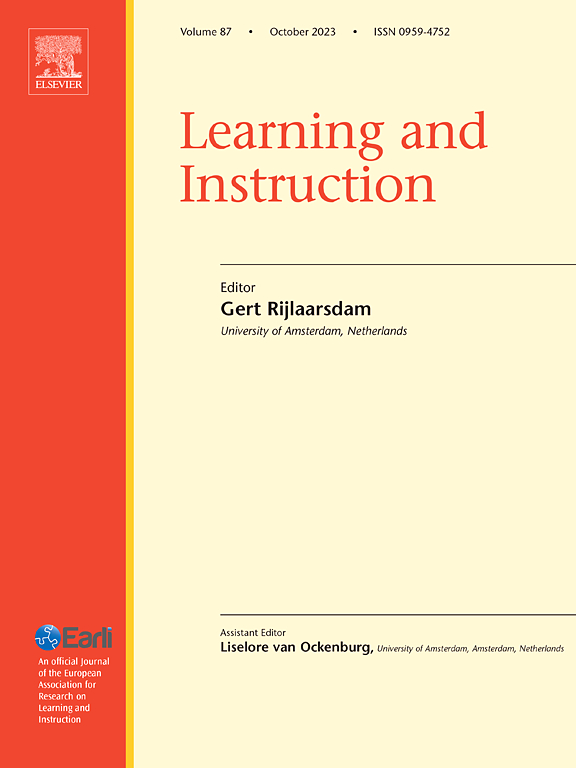Bilingual word learning: Recognizing novel words in context
IF 4.9
1区 教育学
Q1 EDUCATION & EDUCATIONAL RESEARCH
引用次数: 0
Abstract
Background
This study examined the effects of semantic and language variability on novel word learning in bilinguals. We investigated whether varied semantic contexts improve novel word learning in both the dominant and non-dominant language, particularly for novel words across a range of cross-language orthographic overlap.
Methods
Two within-subjects experiments were conducted with English-Spanish (n = 48) and Brazilian Portuguese-English bilinguals (n = 68). Participants studied rare words in repeated or varied semantic contexts across different language conditions (dominant-only, non-dominant-only, or both languages). Reading times for sentences during the study session, accuracy and response times in a semantic relatedness task, measured word learning.
Results
Sentence reading times decreased with each presentation, especially in repeated contexts and when words were presented in the dominant language. Cross-language orthographic overlap significantly moderated reading times of the whole sentence when novel target words were studied in both languages (translation equivalents). The post-test semantic relatedness task presented more complex findings. English-Spanish bilinguals benefited more from words studied in varied semantic contexts, while Brazilian Portuguese-English bilinguals showed an advantage for repeated contexts, likely due to differing task completion strategies and language use patterns between the groups.
Conclusions
While some findings aligned with the Context Variability Hypothesis, other findings revealed more nuanced effects of semantic and language variability. Findings were interpreted within an instance-based theoretical framework of word learning. Language variability across study encounters may provide additional retrieval cues, facilitating novel word learning in bilinguals. However, the effects are moderated by task demands and specific language-pairs.
双语词汇学习:在语境中识别新单词
本研究探讨了语义和语言变异对双语学习者新单词学习的影响。我们研究了不同的语义上下文是否能在优势语言和非优势语言中促进新单词的学习,特别是跨语言正字法重叠的新单词。方法采用英语-西班牙语(n = 48)和巴西葡萄牙语-英语双语者(n = 68)进行两项受试者内实验。参与者在不同的语言条件下(仅占主导地位、仅占非主导地位或两种语言),在重复或不同的语义语境中研究罕见词。在学习过程中阅读句子的时间,语义关联任务的准确性和反应时间,测量单词学习。结果句子的阅读时间随着每次呈现而减少,尤其是在重复的语境和以优势语言呈现单词时。跨语言正字法重叠显著调节了在两种语言中研究新目标词(翻译等效词)时整个句子的阅读时间。后测语义关联任务的结果更为复杂。英语-西班牙双语者从不同语义语境中学习的单词中获益更多,而巴西-葡萄牙-英语双语者在重复语境中表现出优势,这可能是由于两组之间不同的任务完成策略和语言使用模式。虽然一些研究结果与上下文变异性假说相一致,但其他研究结果揭示了语义和语言变异性的微妙影响。研究结果在基于实例的单词学习理论框架内进行了解释。学习过程中的语言差异可能提供额外的检索线索,促进双语者学习新单词。然而,这种影响被任务要求和特定语言对所缓和。
本文章由计算机程序翻译,如有差异,请以英文原文为准。
求助全文
约1分钟内获得全文
求助全文
来源期刊

Learning and Instruction
Multiple-
CiteScore
11.30
自引率
4.80%
发文量
109
期刊介绍:
As an international, multi-disciplinary, peer-refereed journal, Learning and Instruction provides a platform for the publication of the most advanced scientific research in the areas of learning, development, instruction and teaching. The journal welcomes original empirical investigations. The papers may represent a variety of theoretical perspectives and different methodological approaches. They may refer to any age level, from infants to adults and to a diversity of learning and instructional settings, from laboratory experiments to field studies. The major criteria in the review and the selection process concern the significance of the contribution to the area of learning and instruction, and the rigor of the study.
 求助内容:
求助内容: 应助结果提醒方式:
应助结果提醒方式:


